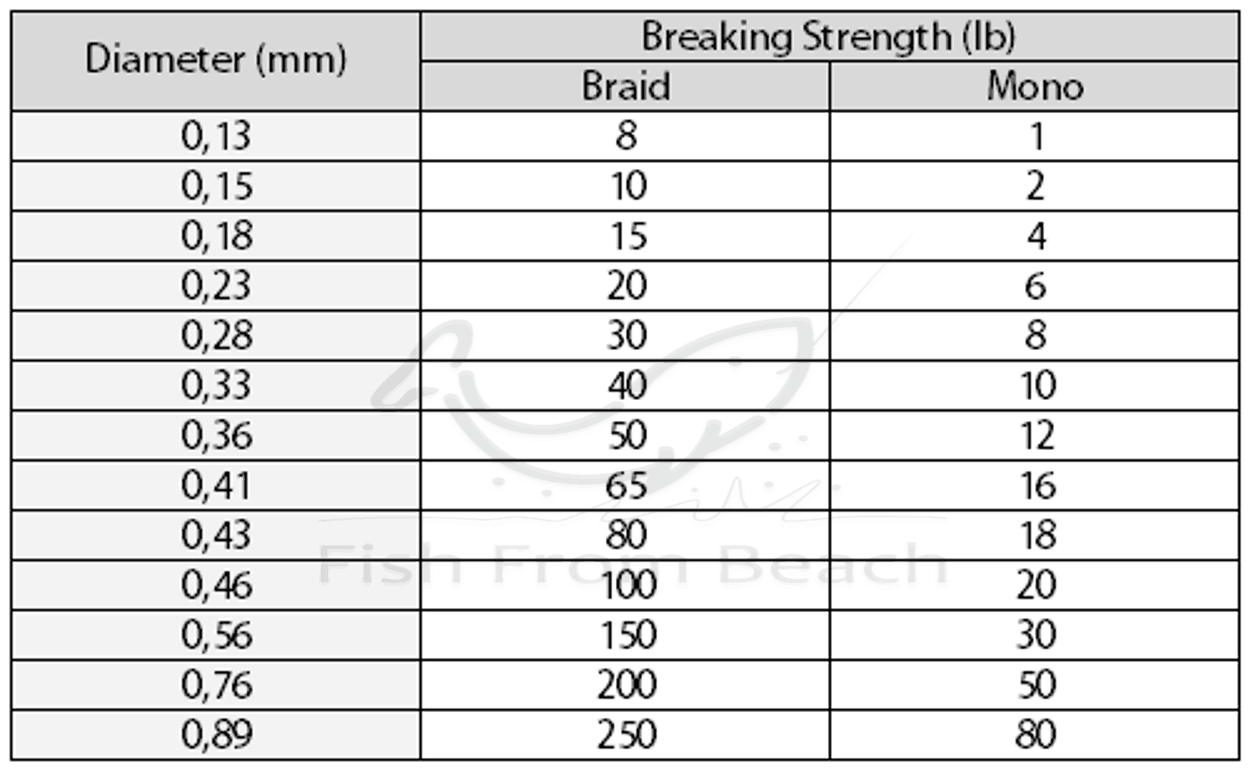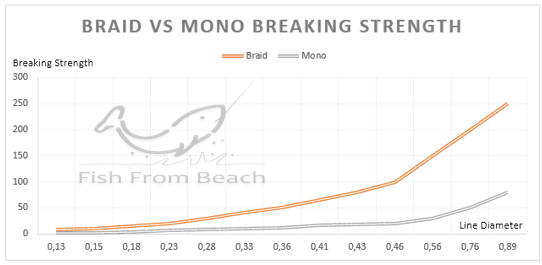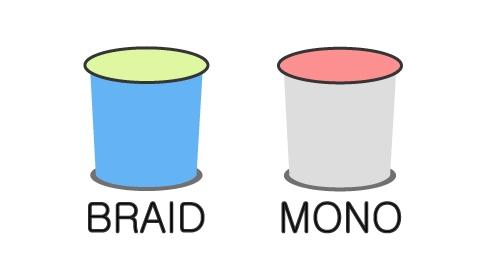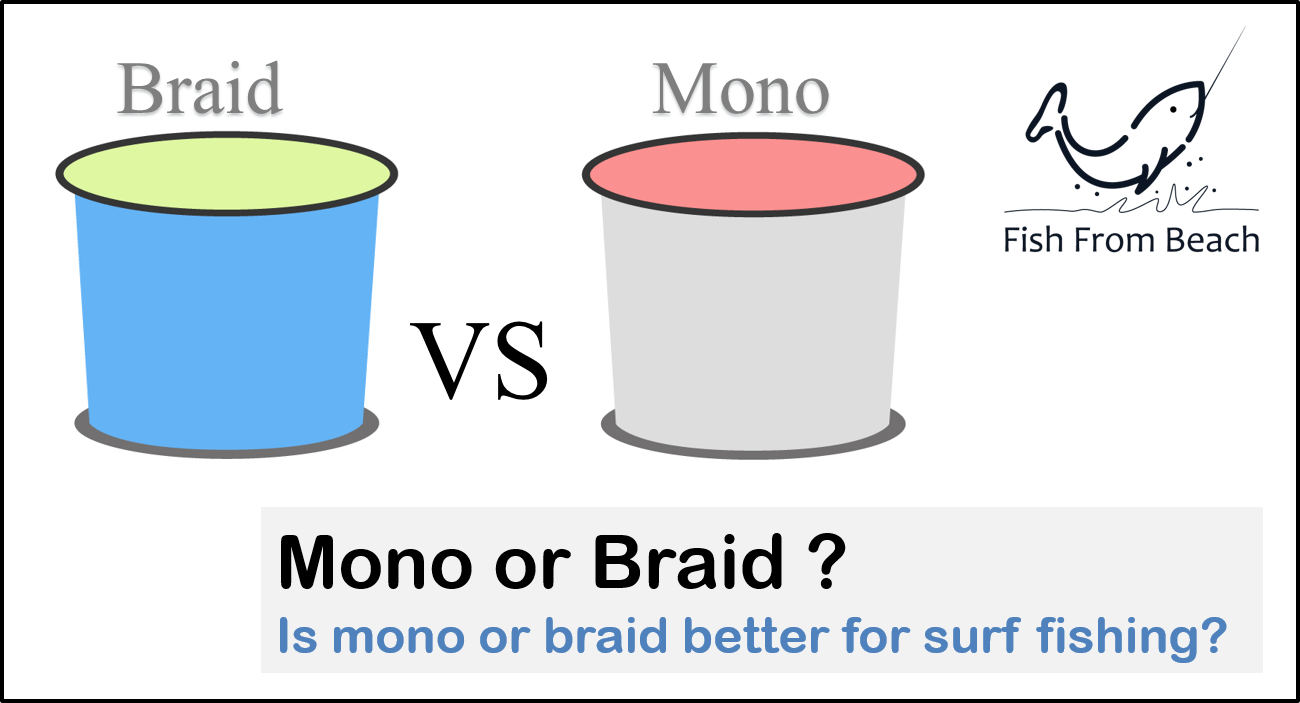Deciding whether to use braid or mono for surf fishing is a difficult and challenging task.
Different surf anglers and shore fishing guides will recommend different line materials. Some will say that braid is the best for beach fishing because it offers good sensitivity and a long casting distance. Others claim that mono is the way to go thanks to its good stretching capacity and its high resistance to abrasion.
It’s an endless debate and you can not blame anyone for choosing one material over the other. Why ? because both mono and braid serve different surf fishing situations.
Generally speaking, the braid is better for fishing in choppy weather and difficult surf conditions because its small diameter allows better resistance to the wind and to the current. In addition, the high sensitivity of the braid facilitates hook setting and bite detection.
In turn, mono is abrasion-resistant and is very effective at dealing with rocky and mixed structures and when targeting sharp-toothed fish. Plus, the high stretching quality of monofilament serves as a safety cushion when targeting large fish, making it an ideal choice for beginner anglers.
In this article, we will discuss in more detail each of the above points, as well as other situations in which the braid and mono are the best options for surf fishing.
What makes braid better for surf fishing ?
High breaking strength
I think that the first obvious advantage of the braid over mono is its higher breaking strength for a given line diameter.
In other words, compared to a mono line of the same thickness, a braided line will take more pressure and tension before it breaks.


As you can see in the table above, a braided line of 0.43 mm diameter can handle up to 80 pounds before breaking, while a mono line of the same thickness breaks under a stress of 18 pounds only.
This is a big advantage when targeting sizeable species because you will have a line that is strong enough to turn large predators without compromising the line diameter and affecting your casting distance and stability in the surf.
Good bite detection
What is most interesting about surf fishing, is that you have to deploy baits at a distance of 70 to 150 yards from the shoreline while staying connected to the other end of the line and able to feel and detect the slightest vibes and movements that happen over there.
For that, you need a sensitive line that is able to effectively transmit energy from the end of the line to your rod tip, and guess what ? there is no better than braid for that.
As the braid does not stretch, everything that happens to the terminal tackle will be effectively and quickly transmitted to your rod and therefore to your hands.
This is extremely beneficial for bite detection, especially in unstable wheater and surf conditions where the wind and wave action keeps bouncing the rod, giving no clear signal whether it’s a bite or simply the wind/wave effect.
The stretching capacity of nylon monofilament is good for shock absorption, but it also reduces and cushions the energy sent from the end of the line, giving no feedback about what’s exactly happening in the surf zone, and making the bite detection a challenging task.
Read our article on how to detect bites when surf fishing ?
Effective hooksets and easy fish fighting
Braided lines will not just transmit vibes from the surf zone to your hands, but they will also go in the opposite direction and transfer all the energy you create to the other end of the line.
This makes fighting fish and hook setting easy and effective because when you have a fish on the line, the braid will accurately transfer all your intentions to the terminal tackle, helping you secure the hookset at the right moment and turn the biting fish effectively.
This is not as easy and simple when you use mono because the elasticity will absorb most of the energy you give to the line. Consequently, you will get a late and weak response to what you intend to do, and you may lose a lot of hookups and catches because of that.
Great casting distance
Braid is definitely the way to go if you want to reach a far spot in the surf zone.
Braided lines have little memory. As a result, they remain in their original form for a long period of time and do not change in shape even after months of use. Thus, when you cast braid, the line is usually straight, which prevents it from hitting on the rod’s guides and hence results in a greater casting distance.
Monofilament lines on the other hand have a better memory, which makes them more willing to take a curly form after a few weeks of being spooled on the reel.
Consequently, when you cast an old mono line, it receives more resistance from the eyes of the rod, limiting the casting distance.
Another reason why braided lines cast further is their small diameter which receives less air pressure during the cast and thus moves further over the surf zone before falling into the water.
The small diameter allows also to spool more line on the reel, which is agreed to be good for the casting distance.
However, as the braid is thin, the coils can dig in each other after a snag or after fighting a big fish, and this can hurt your casting range.
Resistance against current
The small diameter of the braid allows it also to resist the current, providing more stability in the surf zone.
As the line is thin, it cuts better in the water and receives less pressure from the current and the tidal changes.
This is extremely beneficial when fishing in choppy and rough surf conditions because it will help your baited rig to stay in the strike zone where the fish are most likely to bite.
Cost-effective
When it comes to fishing lines, the braid is by far the most expensive option. But also … the most durable too.
Purchasing a braided line will certainly cost you more than mono, but you probably will not need to change the line for 4-5 years as the braid lasts longer and is extremely resistant to deterioration and damage.
Mono is less expensive than braid, but it is also very sensitive to salinity, heat, humidity, and sunlight, making it deteriorate rapidly after a few months of use. This will make you visit the fishing shop more often to get a new line, and in the long run, it is possible to spend more money in mono than you would spend if you bought braid in the first place, which makes the braid the most profitable option.
What makes mono better for surf fishing ?
Good for beginners
When you fight a fish from the shoreline, you need to maintain a pressure strong enough so the fish can’t run away spooling out all your line, but not that strong so you don’t rip the hook off the fish’s mouth.
Maintaining this kind of pressure is easy with mono lines. Why ? Because the stretch will provide you with a margin of safety where you can make mistakes while remaining fine. But when you use a braided line, the slightest mistake will cost you the fish and probably your entire line with it.
This is why the braid requires more practice and learning than mono. Yes, it will respond quickly and effectively to your intentions and will help you make good hooksets, but if you do the wrong moves, it will punish you badly and ruin your fishing day.
Another reason why mono is the way to go for novice surf anglers is that they are easy to tie and provide very strong knots due to their thickness and their ability to stretch.
Braided lines are thin and not as flexible as mono which makes them require special knots that are difficult to learn.
Effective with rocky and mixed seabeds
When your terminal tackle gets snagged between the submerged rock piles, the stretching capacity of a mono line will allow you to get out of the snag with minimal damage.
As the mono stretches, it will absorb every movement you make in order to get out of the snag, and thus, you will keep your rod and reel safe and away from pressure.
Braided lines don’t stretch. As a result, when you try to escape a snag, all pressure will be exerted on the rod, and because of the high breaking strength of the braid, it is possible that the pole breaks before your line does.
Abrasion resistant
Mono is known to be more abrasion-resistant than braid, and this is another reason why you should use mono when fishing rocky structures or when targeting sharp-toothed fish like the snapper, the bluefish, and the sharks.
Yes, braided lines last more and have a longer shelf life, but when exposed to sharp forces, they snap easily causing you the loss of expensive tackle and probably the fish of a lifetime.
Good for targeting large fish
The absorption capacity of mono lines allows to cushion the heavy jerking movements of large fish, which makes mono the best line to use when targeting sizeable fish, especially for novice anglers.
Yes, the braid provides a higher breaking strength that can handle the largest predators swimming in the surf zone, but when using a low pound test and when things get so heavy, the stretching quality of mon will give you more chances to survive and land the fish, while a braided line will easily snap when exposed to pressure exceeding its capacity.
What to use with braid for surf fishing ?
- Use a moderate action rod in order to absorb the jerks of heavy fish and reduce the risk of break-offs during snags. Read this article for more information about the optimal action for surf fishing rods.
- During battles, try to be proactive and anticipate the fish jumps and runs by quickly pointing the rod’s tip seaward.
- Avoid extremely thin lines in order to prevent the coils from digging in each other and limiting the casting distance. A small-diameter line is also more vulnerable to abrasion and sharp-toothed fish.
What to use with mono for surf fishing ?
- It is very important to add an 80-lb shock leader to your mono line in order to absorb the massive stress of power loads. Casting heavy leads with a standard 12-15 lb mono line will easily break your tackle and put your safety and that of others at risk. Read this article for more information about shore fishing shock leaders.
- Always use fast action rods with mono. This is the only way to compensate for the significant stretch of the monofilament and increase your sensitivity bite detection capability.
- The use of monofilament requires attaching enough casting weight to the terminal tackle. The thickness of the mono makes it unstable in the surf zone. Thus, you should always cast enough weight in order to prevent the current from driving your bait away.
Last word : Mono or braid for surf fishing ?
When it comes to the battle between braid and mono for surf fishing, many opinions and perceptions intefere, and two fishermen with the same level of skill and experience can choose different types of lines.
Personally, I prefer braid. Why ? Because for me, the most important thing when surf fishing is to be able to detect bites and to be in total control of the end of the line so that I can easily turn the biting fish and pull them towards the shore.
The low elasticity of braided lines, as well as their high sensitivity, make these tasks simple and effective and allow a higher catches count.
However, I also believe beginner surf anglers should use more mono than braid because the flexibility of mono will allow them to make mistakes and learn from them, without being severely punished.
Recommended surf fishing lines (*)
Note (*): If you make a purchase through links from this website, we may get a small share of the sale from Amazon or other similar affiliate programs.
Surf Fishing Survey
Help us provide you with better content by answering simple questions about your surf fishing experience and knowledge.
We will put the collected responses together and turn them into valuable information that will help you catch more fish from shore 😉
Note: No personal information will be collected with your answer.



